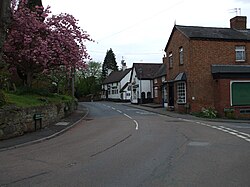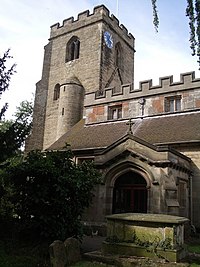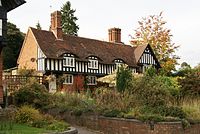Hampton-in-Arden
| Hampton in Arden | |
| Warwickshire | |
|---|---|
 Hampton in Arden, High Street | |
| Location | |
| Grid reference: | SP205815 |
| Location: | 52°25’52"N, 1°41’60"W |
| Data | |
| Population: | 1,787 (2001) |
| Post town: | Solihull |
| Postcode: | B92 |
| Local Government | |
| Council: | Solihull |
| Parliamentary constituency: |
Meriden |
| Website: | Hampton-in-Arden Parish Council |
Hampton-in-Arden is a village in Warwickshire. It lies in the countryside between Birmingham and Coventry. Hampton-in-Arden is a typical Arden village, but is now very much a commuter development for nearby Birmingham, Solihull and Coventry. In 1968, the central part of the village was designated a Conservation Area, which is an "area of special architectural or historic interest, the character or appearance of which it is desirable to preserve or enhance".[1] Its population in the 2001 census was 1,787.[2]
History
Domesday Book entry
Hampton is mentioned in the Domesday Book of 1086, when it was held by Geoffrey of la Gurche:
In Coleshill Hundred Hantone. 10 hides. Land for 22 ploughs. In lordship 2; 2 male and 2 female slaves. 50 villagers with a priest and 16 smallholders have 13 ploughs. A mill at 40d; meadow, 10 acres; woodland 3 leagues long and 3 wide. The value was and is 100s.
All of Geoffrey's lands had been held in King Edward's time freely by Leofwin. Geoffrey's wife was called Aelfeva and her English name suggests that Geoffrey may have acquired his Warwickshire lands through her, by inheritance rather than by confiscation; she may have been Leofwin's heiress.[3] A priest was recorded, implying that a church existed.
Of the name, Hantone, Dugdale states that the name was occasioned from the situation, "hean" in the Old English signifying "high" and was later corrupted to "ham".[4]
Later history
Dugdale could find no mention that Geoffrey of la Gurche had any children and concluded that he must have died without issue, and his lands reverted to the Crown. By a grant of King Henry I all his lands were passed to Nigel de Albani. Nigel had a son, Roger, surnamed Mowbray, from whom, from the middle of the 12th century the de Ardens, became the Lords of the Manor.[4] Afterwards it passed by marriage to the de Montford family of Coleshill and then subsequently reverted to the Crown. Queen Elizabeth I granted the manor to Robert Dudley, Earl of Leicester in 1570 but reverted to the Crown after his death. In 1625, it was assigned to Queen Henrietta Maria, wife of King Charles I.
In the early 19th century the manor was sold to Isaac William Lillingston who later sold the Manor of Hampton to Sir Robert Peel (the former Prime Minister). On Sir Robert's death in 1850, the manor was inherited by his son, Frederick, who did much to 'modernise' Hampton, demolishing many half-timbered and thatched cottages. He employed the architect W E Nesfield to build new dwellings, shops and lodges.[1]
Parish church

The parish church of St Mary and St Bartholomew has a chancel, nave with narrow aisles, west tower, south porch, and north vestry. The chancel is of about mid-12th-century date. It is comparatively long and narrow for the period, in a church of this size, and it has an unusual north doorway near the west end; it is possible that it represented the complete church at least for a short time.
The nave, if not of the same date, was built soon afterwards and had a late 12th-century south aisle, of which the arcade remains. Possibly the nave was of the same width as the chancel, but was widened to the north by about 5 feet. About the middle of the 13th century and a narrow north aisle and arcade added. The chancel arch was widened at the same time to the utmost limits permitted by the width of the chancel. For some reason, probably weakness, the north aisle was rebuilt late in the 14th century on the old foundations of the narrow aisle. This was followed by a similar rebuilding of the south aisle early in the 15th century, again without widening it. About the same time the west tower was begun, but carried up only a short way, the completion being delayed until late in the century.
The last mediaeval alteration was the building of the clearstory in the 16th century in place of the old steeply pitched roof indicated by the lines on the tower.[5]
The tower bore a tall spire "till by the extraordinary violence of lightning and thunder happening on St Andrew's Day, in the night, in the year 1643, it was cloven, and fell to the ground: at which time the whole fabrick, with the tower, were torn in divers places." [4]
The south porch and north vestry are modern, and various repairs and restorations have been executed to other parts. The chancel was rebuilt in 1879 with the old material [5] overseen by the architect W. E. Nesfield.[1] All the roofs are modern.[5]
-
The East Window
-
The Font
-
Heart Shrine and Priests door
Sights about the town

There are some well preserved 17th century and timber framed houses, some of which are listed.[5]
Outside the village, to the south-east, is the 15th-century Packhorse Bridge over the River Blythe and on the former route to Kenilworth.[1] The bridge is only 5 feet wide between the low parapets, consisting of five bays with ancient stone piers having pointed cut-water faces on the west side against the flow of the stream—and square projections on the east. The three northern arches are segmental-pointed, the southern two have been rebuilt with brick arches. East of the bridge is a ford.[5]
The war memorial lists the names of 23 men of the parish who were killed in the two World Wars. It is dedicated; To the Glory of God and in Memory of the men of Hampton In Arden who gave their lives for their country in the cause of freedom 1914-1918 and below Sons of this place let this of you be said that you who live are worthy of your dead 1939-1945.
-
15th-century Packhorse Bridge
-
Yew Tree Cottage
-
Cottages on the High Street
-
The White Lion Public House
-
War Memorial
References
- ↑ 1.0 1.1 1.2 1.3 Solihull Council Web site
- ↑ Office for National Statistics : Census 2001 : Parish Headcounts : Solihull Retrieved 2009-11-22
- ↑ Domesday Book for Warwickshire, Phillimore edited by John Morris ISBN 0 85033 141 2
- ↑ 4.0 4.1 4.2 The Antiquities of Warwickshire, William Dugdale, 1656
- ↑ 5.0 5.1 5.2 5.3 5.4 A History of the County of Warwick: Volume 4 (1947), pp. 81-86. [1]







